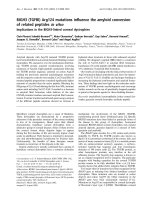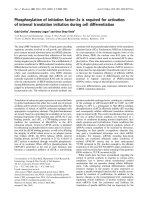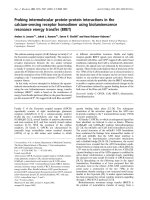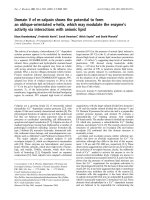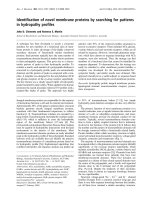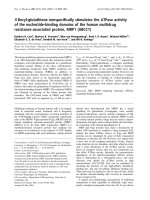Báo cáo y học: "Percutaneous dilatation tracheostomy: which technique is the best for the critically ill patient, and how can we gather further scientific evidence" pptx
Bạn đang xem bản rút gọn của tài liệu. Xem và tải ngay bản đầy đủ của tài liệu tại đây (36.21 KB, 3 trang )
319
GWDF = guidewire dilating forceps.
Available online />Numerous reports have been published in recent years
regarding various methods of percutaneous tracheostomy
(for review [1–3]). One of the general conclusions is that
techniques that require the use of sharp instruments (e.g.
Griggs’ guidewire dilating forceps [GWDF] technique)
apparently result in more complications. In addition,
complications of percutaneous tracheostomy appear most
likely to occur during the process of learning the technique –
the ‘learning curve’. Several large clinical trials reported a
rather low incidence of complications with various
percutaneous tracheostomy techniques [4–7], and those that
directly compared different techniques for percutaneous
tracheostomy [8–11] found them to be equally safe and
efficacious when used by experienced physicians. Moreover,
thus far there is no scientific evidence to support the current
superiority of any single percutaneous tracheostomy
technique in terms of safety and outcomes. All authors
agreed that percutaneous tracheostomy is only suitable for
elective procedures and definitely not in the emergency
setting. Rather, conventional cricothyroidotomy should be
performed immediately in an emergency situation to
safeguard the airway.
This issue of Critical Care reports work by Fikkers and
coworkers [12]. The authors present data on 342 patients
who underwent percutaneous tracheostomy during their
course of intensive care treatment in a large teaching
hospital. The data were collected in two consecutive periods,
during which the care team performed percutaneous
tracheostomy exclusively with the Griggs’ GWDF technique
(1997–2000) or with the conic dilatation technique (Ciaglia
Blue Rhino
TM
; Cook Critical Care, Bloomington, IN, USA;
2000–2003). Examining these data sets, the authors
observed differences between the two techniques (or
periods) in only four out of 33 possibly related complications
(categories: perioperative; while cannulated; long-term). The
numbers of difficult dilatations and of minor bleeding were
higher with the conic dilation technique (23 versus 0
[P < 0.01] and 24 versus 11 [P = 0.02], respectively). Voice
problems and/or persistent hoarseness were also reported
Commentary
Percutaneous dilatation tracheostomy: which technique is the
best for the critically ill patient, and how can we gather further
scientific evidence?
Ansgar Brambrink
Visiting Associate Professor, Oregon Health & Science University, Department of Anesthesiology and Peri-Operative Medicine, Portland, Oregon, USA
Corresponding author: Ansgar Brambrink,
Published online: 8 September 2004 Critical Care 2004, 8:319-321 (DOI 10.1186/cc2968)
This article is online at />© 2004 BioMed Central Ltd
Related to Research by Fikkers et al., see page 395
Abstract
Percutaneous dilatation tracheostomy in the intensive care setting presents an increasingly important
concept for establishing a large-bore tracheal airway with minimal surgical intervention. Over the last
years, different technical solutions have been studied to assess their respective risks and benefits to
determine whether one method is actually superior. A recent observational study comparing two such
techniques prompted this commentary, which reviews the current literature, comments on study design
and suggests interesting topics for future research in this field.
Keywords conic dilatation technique, fiberoptic brochoscopy guidance, Griggs' guide wire dilating forceps
(GWDF) technique, intensive care medicine, percutaneous dilatation tracheostomy, study design,
320
Critical Care October 2004 Vol 8 No 5 Brambrink
more frequently after conic dilatation (22 patients versus 9
patients [P < 0.01]). Cosmetic problems were more common
with the GWDF technique (10 versus 2 [P = 0.03]). In
contrast, Fikkers and coworkers found no differences in time
needed for the procedure, or in days spent in the intensive
care unit. They concluded that both techniques are equally
safe and effective.
This new work from Fikkers and coworkers in large part
summarizes data (271 patients) from previous reports from
the same group [13,14]. Their report in this issue includes 71
additional patients who all received percutaneous
tracheostomy using the conic dilatation technique (Ciaglia
Blue Rhino
TM
), resulting in similar sample sizes for the study
groups. The authors earlier reported on 100 of the patients
who received conic dilatation tracheostomy [13], comparing
data with a prior report on 171 patients cannulated using the
GWDF technique [14]. In that report they have already
concluded that these two techniques are comparably safe
and easy to perform, similar to their findings presented in this
issue.
Fikkers and coworkers indeed address a very important
issue, because they analyze two different techniques for
percutaneous tracheostomy with respect to practicability and
the specific risks involved for patients in the intensive care
setting. However, some drawbacks in their study design limit
the ability to draw valuable evidence-based conclusions from
this work regarding which of the two techniques may be
more appropriate in clinical practice from the viewpoint of the
intensivist. Because a sequential study design over a period
of 6 years was used, the data might have been subject to
differences in patient selection and/or medical staff between
the two time periods, when one technique was applied
exclusively. This could have influenced the results, partly
accounting for the apperant contrast with current literature
(e.g. fewer complications with the GWDF technique than
with the Ciaglia Blue Rhino
TM
technique). Also, apparently, a
rather large group of individuals performed the procedures
described, and it remains unclear what kind of training they
received before their participation in the study. This suggests
that various effects of multiple learning curves and different
degrees of experience might have confounded the results,
and therefore possible benefits of one technique over the
other could have been obscured. Finally, during the period of
data collection the authors implemented a new step in the
classical technique of conic dilatation tracheostomy
(introduction of a Crile’s forceps for blunt dissection of the
pretracheal tissue), but it is unclear whether they controlled
for the resulting effects in their data analysis and
presentation.
Thus, Fikkers and coworkers’ recent work exemplifies a
critical dilemma in clinical research. The study presented may
provide highly important information for the institution where
it was conducted, because the data have probably already
been used for institutional quality management in intensive
care medicine. However, the same information is not
necessarily helpful for deciding between different methods
for elective long-term airway management in critically ill
patients in general. Only studies that are performed in a
prospective, randomized and controlled manner will be able
to gather further scientific evidence regarding the risks and
benefits of different techniques for percutaneous dilatation
tracheostomy. In addition, such studies should try to
implement the most recent developments (e.g. [11]),
enhancing their appreciation within the research community
and fostering progress in the field.
The work by Fikkers and coworkers raises some interesting
questions regarding percutaneous dilatation tracheostomy in
the intensive care setting, and these indeed warrant future
research. First, the preference of percutaneous tracheostomy
over open tracheostomy is still intensely debated (for review
[15,16]). Fikkers and coworkers, like other authors in the
past, did not report findings in the patients who received
surgical tracheostomy or were left intubated during the
period while study patients were assigned to percutaneous
tracheostomy. Provided that an appropriate study design is
used, such parallel data may help to guide clinicians in their
decision making in individual patients. Second, the value of
fibreoptic endoscopy in guiding tracheal puncture and
placement of the tracheal cannula during percutaneous
tracheostomy is unquestioned [8–10]. Even though Fikkers
and coworkers apparently provided fibreoptic brochoscopy
during parts of the procedure, they still observed a relatively
high incidence of puncture of the posterior tracheal wall,
puncture of the endotracheal tube, or subsequent
oesophageal perforation or false route during placement of
the tracheal cannula. It remains unclear whether this was
related to the level of procedural experience in the individuals
performing the procedures or due to other factors. These
observations shed light on the benefits but also on the
apparent limitations of fibreoptic guidance of percutaneous
tracheostomy, and may provide a stimulus for efforts to clarify
this issue.
In summary, Fikkers and coworkers, in two series (each over
a 3-year period), studied the effects of two well established
techniques of percutaneous tracheostomy (Griggs’ GWDF
technique and the conic dilatation technique [Ciaglia Blue
Rhino
TM
]) in a large number of patients. They found both
methods to be equally safe and effective. However, because
they recognise the limitations of a retrospective analysis, they
plan to conduct a prospective, randomized study to compare
GWDF and conic dilatational tracheostomies. The findings of
that study will be very important because they may indeed
determine the role for both techniques in critical care
medicine.
Competing interests
The author declares that he has no competing interests.
321
References
1. Powell DM, Price PD, Forrest LA: Review of percutaneous tra-
cheostomy. Laryngoscope 1998, 108:170-177.
2. Moe KS, Stoeckli SJ, Schmid S, Weymuller EA Jr: Percutaneous
tracheostomy: a comprehensive evaluation. Ann Otol Rhinol
Laryngol 1999, 108:384-391.
3. Bobo ML, McKenna SJ: The current status of percutaneous
dilational tracheostomy: an alternative to open tracheostomy.
J Oral Maxillofac Surg 1998, 56:681-685; discussion 685-686.
4. Kearney PA, Griffen MM, Ochoa JB, Boulanger BR, Tseui BJ,
Mentzer RM Jr: A single-center 8-year experience with percu-
taneous dilational tracheostomy. Ann Surg 2000, 231:701-
709.
5. Muhammad JK, Major E, Wood A, Patton DW: Percutaneous
dilatational tracheostomy: haemorrhagic complications and
the vascular anatomy of the anterior neck. A review based on
497 cases. Int J Oral Maxillofac Surg 2000, 29:217-222.
6. Vigliaroli L, De Vivo P, Mione C, Pretto G: Clinical experience
with Ciaglia’s percutaneous tracheostomy. Eur Arch Otorhino-
laryngol 1999, 256:426-428.
7. Walz MK, Peitgen K, Thurauf N, Trost HA, Wolfhard U, Sander A,
Ahmadi C, Eigler FW: Percutaneous dilatational tracheostomy:
early results and long-term outcome of 326 critically ill
patients. Intensive Care Med 1998, 24:685-690.
8. Byhahn C, Wilke HJ, Lischke V, Rinne T, Westphal K: Bedside
percutaneous tracheostomy: clinical comparison of Griggs
and Fantoni techniques. World J Surg 2001, 25:296-301.
9. Byhahn C, Wilke HJ, Halbig S, Lischke V, Westphal K: Percuta-
neous tracheostomy: ciaglia blue rhino versus the basic
ciaglia technique of percutaneous dilational tracheostomy.
Anesth Analg 2000, 91:882-886.
10. Westphal K, Byhahn C, Wilke HJ, Lischke V: Percutaneous tra-
cheostomy: a clinical comparison of dilatational (Ciaglia) and
translaryngeal (Fantoni) techniques. Anesth Analg 1999,
89:938-943.
11. Byhahn C, Westphal K, Meininger D, Gurke B, Kessler P, Lischke
V: Single-dilator percutaneous tracheostomy: a comparison
of PercuTwist and Ciaglia Blue Rhino techniques. Intensive
Care Med 2002, 28:1262-1266.
12. Fikkers BG, Staatsen M, Lardenoije SGGF, van den Hoogen FJA,
van der Hoeven JG: Comparison of two percutaneous tra-
cheostomy techniques, guide wire dilating forceps and
Ciaglia Blue Rhino: a sequential cohort study. Crit Care 2004,
8:R299-R305.
13. Fikkers BG, van Heerbeek N, Krabbe PF, Marres HA, van den
Hoogen FJ: Percutaneous tracheostomy with the guide wire
dilating forceps technique: presentation of 171 consecutive
patients. Head Neck 2002, 24:625-631.
14. Fikkers BG, Briede IS, Verwiel JM, van den Hoogen FJ: Percuta-
neous tracheostomy with the Blue Rhino technique: presenta-
tion of 100 consecutive patients. Anaesthesia 2002, 57:
1094-1097.
15. Massick DD, Yao S, Powell DM, Griesen D, Hobgood T, Allen JN,
Schuller DE: Bedside tracheostomy in the intensive care unit:
a prospective randomized trial comparing open surgical tra-
cheostomy with endoscopically guided percutaneous dila-
tional tracheotomy. Laryngoscope 2001, 111:494-500.
16. Grover A, Robbins J, Bendick P, Gibson M, Villalba M: Open
versus percutaneous dilatational tracheostomy: efficacy and
cost analysis. Am Surg 2001, 67:297-301; discussion 301-302.
Available online />

